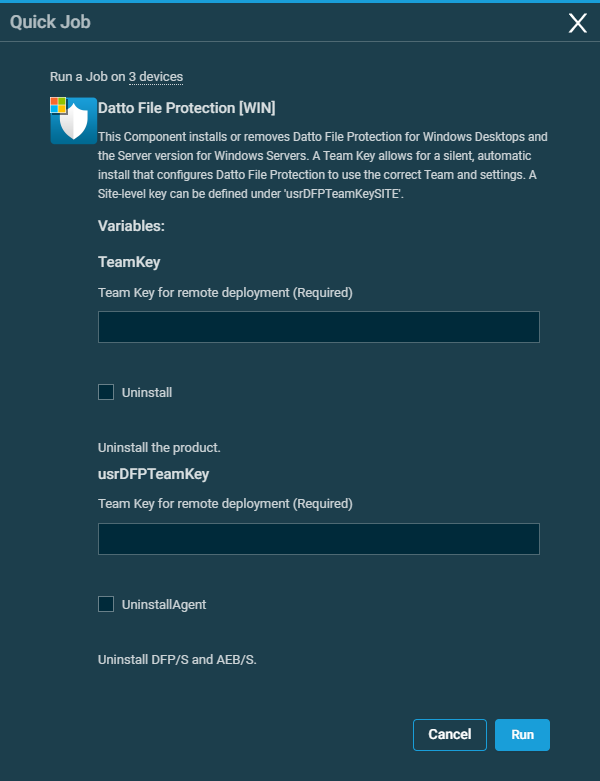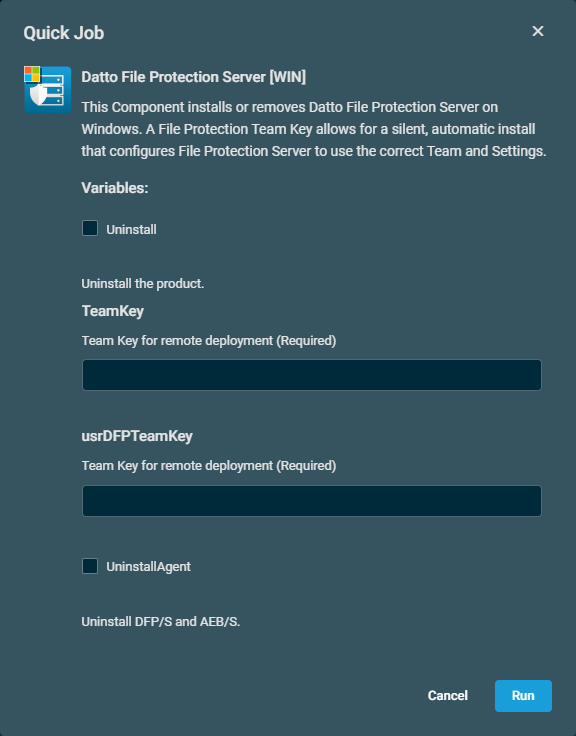Datto File Protection Integration
PERMISSIONS For components, refer to ComStore > ComStore in Permissions.
PERMISSIONS For Software Management, refer to Global > Manage, Global > Policies, Sites > Manage, and Sites > Policies in Permissions.
PERMISSIONS For monitors, refer to Sites > Monitor in Permissions.
PERMISSIONS For policies, refer to Global > Policies and Sites > Policies in Permissions.
PERMISSIONS For UDF configuration, refer to Setup > Account Settings/Global Settings in Permissions.
NAVIGATION Various navigation paths. For details, see below.
About Datto File Protection
Datto File Protection is Datto's cloud-based file backup service. It consists of the following components:
- File Protection Desktop: File Protection Desktop is installed on a computer and is responsible for securely transmitting data between the device on which it is installed and the File Protection service. File Protection Desktop can be installed silently on a user's machine via an RMM tool, such as Datto RMM.
- File Protection Server: File Protection Server is designed specifically to run on server operating systems to back up the files stored on local, attached, or network drives. It always runs in service mode, which ensures that it's constantly backing up even on unattended devices.
- File Protection Online: A web interface that provides end users with access to device-related functions in the File Protection service, like restoring devices from a backup.
- File Protection Manager: A web interface that provides access to all administrative and provisioning functions for partners.
For more detailed information about Datto File Protection, visit the Datto File Protection Manager Help.
About the Datto File Protection Integration
The integration offers the following major benefits:
- Seamless, silent deployment and removal of Datto File Protection using Datto RMM. The Datto File Protection team key allows you to install or uninstall File Protection Desktop without end user interaction. Refer to Install File Protection Desktop.
- Alerting on key problems of Datto File Protection, like devices not running backups for days. Tickets can also be created from the alerts in Autotask if the ticket integration is enabled. Refer to Configure ticket settings.
- Visibility on Datto File Protection status in Datto RMM. Any managed device will display the Datto File Protection status, backup size, and last backup day. You can use this information in reports or filters. Moreover, if you use the Autotask Integration, and the user-defined field (UDF) synchronization is enabled, the Datto File Protection information will be synced to your Autotask configuration items. Refer to Configure device synchronization.
Prerequisite
You need to have a team key to be able to associate the devices with the correct team. Refer to Install File Protection Desktop.
How to...
Before deploying File Protection Desktop, a team key must be created in the Datto File Protection Manager. The team key is used during the installation of File Protection Desktop to associate the device with the correct team, and it also assigns a set of default folders for the backup. For information on how to create or find the Datto File Protection team key, refer to this topic in the Datto File Protection Manager Help: Deployment Configuration.
You can install File Protection Desktop via Datto RMM by using one of the following methods:
- Navigate to Automation > ComStore. Refer to ComStore.
- Search for Datto File Protection and add the desired Windows or macOS deployment component to your Component Library. Refer to Download a component.
- Navigate to a device or a list of devices that you wish to install File Protection Desktop on.
- Create either a quick job or a scheduled job for the selected devices and use the Datto File Protection component in the job. Refer to Quick jobs and Scheduled jobs.
- Ensure that the Uninstall variable is left unselected when configuring the component.

NOTE Selecting the Uninstall variable would trigger the File Protection Desktop uninstallation process. Uninstalling File Protection Desktop does not require a team key.
- In the TeamKey field, enter the team key obtained from the Datto File Protection Manager.
TIP Alternatively, you can leave this field blank if you have defined a global or site-level variable called usrDFPTeamKeySITE in your Datto RMM account. The variable will be used in the back end when running the job. If you have defined both a global and a site-level variable, the site-level variable will take priority.For information on variables, refer to the following topics: Variables and Import Site Variables in Global Settings and Variables in Creating or editing a site.
TIP If you leave this field blank, and no global or site-level team key variable is defined, the end user will be prompted to enter a team key when they launch the application to finish the installation process.
- Finish creating the job. Once the job has run, File Protection Desktop will be installed on the selected devices.
- The installation may take a few minutes. Once it's completed, you can check the output of the installation. Refer to StdOut/StdErr.
NOTE The installation is completely silent; however, users are required to log off and log back in to their device or reboot it for Datto File Protection to start automatically. Users can start Datto File Protection manually as well.
- Ensure you have defined your team key as a global or site-level variable called usrDFPTeamKeySITE.
NOTE For information on variables, refer to the following topics: Variables and Import Site Variables in Global Settings and Variables in Creating or editing a site.
- Configure a Software Management policy for Datto File Protection. Refer to Software Management policy.
- During the installation process, the global or site-level team key variable will automatically be applied, and the Software Management policy will install File Protection Desktop on applicable devices.
NOTE If you have defined both a global and a site-level variable, the site-level variable will take priority.
Before deploying File Protection Server, a team key must be created in the Datto File Protection Manager. The team key is used during the installation of File Protection Server to associate the device with the correct team, and it also assigns a set of default folders for the backup. For information on how to create or find the Datto File Protection team key, refer to this topic in the Datto File Protection Manager Help system: Deployment Configuration.
You can install File Protection Server via Datto RMM by using the following method:
NOTE Installation of Datto File Protection Server through Datto RMM is available only for Windows OS devices at this time.
- Navigate to Automation > ComStore. Refer to ComStore.
- Search for and add the Datto File Protection Server [WIN] component to your Component Library. Refer to Download a component.
- Navigate to a device or a list of devices that you wish to install File Protection Server on.
- Create either a quick job or a scheduled job for the selected devices and use the Datto File Protection Server [WIN] component in the job. Refer to Quick jobs and Scheduled jobs.
- Ensure that the Uninstall variable is left unselected when configuring the component.

NOTE Selecting the Uninstall variable would trigger the File Protection Server uninstallation process. Uninstalling File Protection Server does not require a team key.
- In the TeamKey field, enter the team key obtained from the Datto File Protection Manager.
TIP Alternatively, you can leave this field blank if you have defined a global or site-level variable called usrDFPTeamKeySITE in your Datto RMM account. The variable will be used in the back end when running the job. If you have defined both a global and a site-level variable, the site-level variable will take priority.For information on variables, refer to the following topics: Variables and Import Site Variables in Global Settings and Variables in Creating or editing a site.
TIP If you leave this field blank, and no global or site-level team key variable is defined, the end user will be prompted to enter a team key when they launch the application to finish the installation process.
- Finish creating the job. Once the job has run, File Protection Server will be installed on the selected devices.
- The installation may take a few minutes. Once it's completed, you can check the output of the installation. Refer to StdOut/StdErr.
NOTE The installation is completely silent; however, users are required to log off and log back in to their device or reboot it for Datto File Protection to start automatically. Users can start Datto File Protection manually as well.
- Navigate to Automation > ComStore. Refer to ComStore.
- Search for and add the Datto File Protection and add the desired Windows or macOS monitoring component to your Component Library. Refer to Download a component.
- To monitor an individual device's Datto File Protection status, create a Component monitor. Refer to the Component monitor section in Creating a monitor.
To monitor multiple devices' Datto File Protection status, create a Monitoring policy and add a Component monitor to it. Refer to Monitoring policy. - In the monitor details, select the downloaded Datto File Protection monitoring component as the Component monitor and configure the variables based on your monitoring needs. Check the description field of each variable for information on how it will affect the monitor.
- Specify how often the Component monitor should run.
NOTE We recommend that you set this interval to at least one hour. Running the Component monitor more often than this should not be necessary.
- Configure the rest of the monitor details and save the changes.
The targeted devices will now be monitored. An alert will be raised according to the monitor configuration, and the user-defined field information will be displayed on the device summary page. Refer to UDFs.
By default, the integration uses user-defined fields 1 and 2 to show a device's Datto File Protection status on the device summary page in Datto RMM. We recommend that you rename these user-defined field names to reflect what information is captured through the integration. To learn how to change the field names, refer to the User-Defined Fields section in Global Settings.
EXAMPLE For example, you can rename the Global Label of User-defined field 1 to DFP Status and that of User-defined field 2 to DFP Version | ID.



